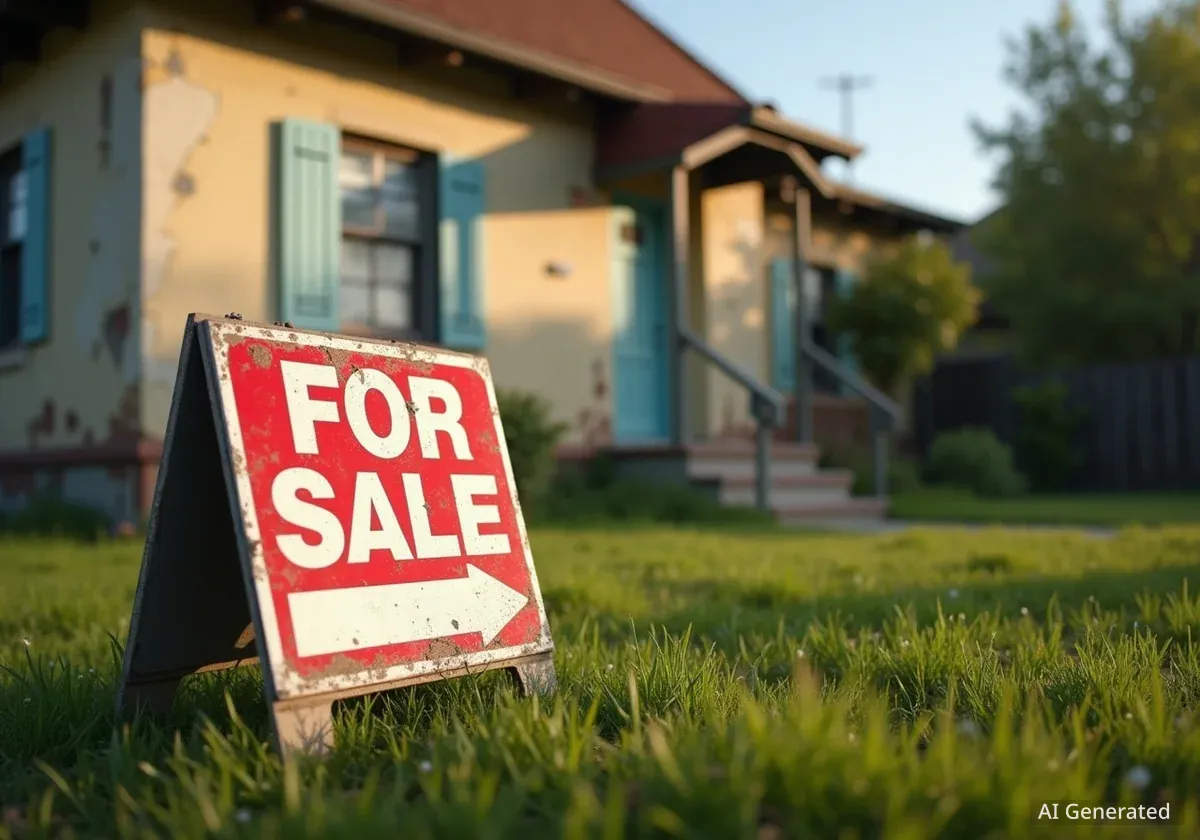The U.S. housing market is expected to see a significant increase in home sales in 2025, according to Lawrence Yun, Chief Economist for the National Association of REALTORS® (NAR). This optimistic forecast is based on projections of declining mortgage rates and an expanding supply of available homes, signaling a potential shift from the sluggish activity of recent years.
Key Takeaways
- Increased Sales Activity: NAR forecasts a notable rise in home sales throughout 2025, driven by lower mortgage rates and more housing inventory.
- Affordability Remains a Hurdle: While overall sales are expected to improve, the market for affordable, entry-level homes will likely remain constrained due to a persistent lack of supply.
- Midwest Leads in Affordability: The Midwest region is positioned for strong performance, with median home prices approximately 22% lower than the national average, attracting budget-conscious buyers.
- Market Normalization: The forecast suggests a move toward a more balanced market, with buyers gaining more time and negotiating power compared to the highly competitive conditions of previous years.
A Shift from Recent Market Slowdown
For the past several years, the U.S. housing market has been characterized by slow sales activity. Lawrence Yun identifies two primary factors behind this trend: elevated mortgage rates, which have strained buyer budgets, and a limited number of homes for sale, which has created intense competition for available properties.
However, Yun indicates that these conditions are beginning to change. The gradual decline in mortgage rates and a steady increase in housing inventory are setting the stage for a more active market. "The declining mortgage rates and increasing inventory are expected to significantly boost home sales throughout 2025," Yun stated, suggesting a move towards a healthier, more balanced environment.
Understanding the Key Drivers
Two main forces are shaping the 2025 outlook. First, mortgage rates, which directly impact a buyer's monthly payment and overall purchasing power. Even small decreases can make homeownership accessible to a wider pool of applicants. Second, housing inventory, or the number of homes for sale. More supply gives buyers more choices and tends to stabilize price growth.
Diverging Trends in Market Segments
The anticipated recovery is not expected to be uniform across all price points. Yun's analysis highlights a clear division between the high-end and affordable segments of the market.
Strength in the High-End Market
Homeowners who have built substantial equity during the recent period of rapid price appreciation are in a strong financial position. Yun notes that record-high housing wealth, combined with a robust stock market, empowers these individuals to "trade up" to more expensive properties.
This financial strength is expected to fuel activity in the luxury and upper-tier markets. These buyers can leverage their existing assets to navigate the current price landscape and secure their next home.
Challenges in the Affordable Sector
In contrast, the market for affordable homes faces persistent headwinds. According to Yun, a significant lack of inventory at lower price points is holding back sales in this category. Even with the benefit of lower interest rates, first-time buyers and those with modest budgets will continue to struggle if there are not enough suitable homes available.
This supply-side issue remains one of the most significant challenges for the housing market's overall health and accessibility.
First-Time Buyer Update
Recent data from August shows that first-time homebuyers accounted for 28% of sales. This figure is up from 26% a year prior, indicating that despite affordability challenges, new entrants are still finding ways into the market.
Regional Performance and Affordability Hotspots
Geographic location plays a crucial role in housing market dynamics, with affordability being a key differentiator. Yun's analysis points to the Midwest as a region of notable strength and opportunity.
The Midwest Advantage
The Midwest has recently been the best-performing region in the country, a trend Yun attributes directly to its relative affordability. The median home price in the Midwest is a substantial 22% below the national median. This price advantage makes it an attractive destination for buyers who are priced out of more expensive coastal markets.
"The Midwest was the best-performing region recently, and the reason is straightforward: relatively affordable market conditions," Yun explained.
As market conditions improve nationally in 2025, this inherent affordability could draw even more attention and investment to the region.
A Look at the Latest Regional Data
Data from August provides a snapshot of these regional differences:
- Midwest: Sales increased by 2.1% month-over-month and 3.2% year-over-year. The median price was $330,500.
- South: Sales were up 3.4% year-over-year, with a median price of $364,100.
- Northeast: Sales declined 2.0% year-over-year, while the median price reached $534,200.
- West: As the most expensive region with a median price of $624,300, sales were down 1.4% from the previous year.
Key Market Indicators Point to Normalization
Beyond sales and prices, several other metrics from NAR's latest report suggest the market is shifting toward a more sustainable pace. These indicators provide a deeper understanding of the current environment and what buyers and sellers can expect.
Increased Time on Market
Properties remained on the market for a median of 31 days in August, an increase from 26 days a year ago. This slowdown gives potential buyers more time to consider their options and conduct due diligence, reducing the pressure to make rushed decisions. It also indicates a shift in negotiating power more toward the buyer.
Inventory and Supply Levels
The total housing inventory stood at 1.53 million units at the end of August. While this is down slightly from the previous month, it represents an 11.7% increase from one year ago. At the current sales pace, this translates to a 4.6-month supply of homes, moving closer to the 6-month supply generally considered indicative of a balanced market.
National Price Snapshot (August Data)
The median existing-home price for all housing types was $422,600, marking a 2.0% increase from the same period last year. This continued, albeit modest, price growth reflects sustained underlying demand in the market.
Outlook for Buyers and Sellers in 2025
Based on Yun's forecast, the housing market in 2025 will present a different set of opportunities and challenges for participants.
For buyers, the combination of more available homes and stabilizing prices is welcome news. The frantic bidding wars of the recent past are expected to become less common, allowing for a more deliberate home-buying process. Declining mortgage rates will also improve purchasing power.
For sellers, the market will likely remain favorable, but strategic pricing will be crucial. With more competition from other listings, homes that are well-maintained and priced according to current market conditions will have the best chance of selling promptly. The era of expecting multiple offers significantly above the asking price may be fading in many areas.
Overall, the 2025 housing market is projected to be one of measured recovery and stabilization, moving away from the extremes of recent years toward a more accessible and predictable environment for a greater number of Americans.





